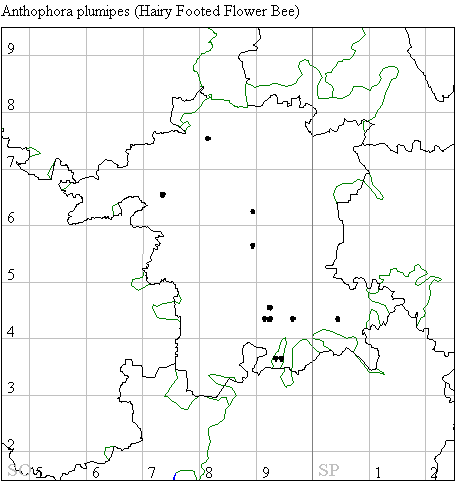
Worcestershire Record No. 22 April 2007 pp. 27-28
Geoff Trevis
First, we need to deal with the matter of nomenclature as this demonstrates the pitfalls of using English names. I have spoken to several people about the species to discuss the possibility of undertaking a survey and a number have said “isn’t that the mason bee”. Now A. plumipes is certainly a hole nester and will use holes in old walls or crumbling mortar. However, I have not come across it referred to as the mason bee and, therefore, I went back to several information sources and have not found this common name in use. Indeed, the term “mason bee” is more usually applied to Osmia species, particularly Osmia rufa, the red mason bee, whose activities in old walls has been known to demolish buildings.
There are five Anthophora species on the British list; A. bimaculata, A. furcata, A. plumipes, A. quadrimaculata and A. retusa. Of these, A. bimaculata, A. quadrimaculata and A. retusa are relatively rare and appear to have a strongly south-eastern distribution, though this may, of course, merely reflect recording effort. However, A. furcata and A. plumipes are not considered scarce or threatened. Whilst still having a strong south-easterly distribution, they are found much more widely and are significantly under recorded in Worcestershire. Indeed, there are currently no records of A. furcata in Worcestershire. The county distribution of A. plumipes is shown below.

We would, therefore, like to obtain a more complete picture of the species’ distribution in the county and would welcome any records you can send.
A. plumipes can be found in a variety of habitats, including most gardens, between March and late May. It looks like a small bumblebee, either black (female) or brown (male) but is clearly distinguished from the bumblebees by its flight. It moves very swiftly then stops, hovering for a moment, in front of its chosen flower. This is very different from the slow, steady flight of the bumblebees. If approached closely enough, which is exceedingly difficult, the male can be seen to have long hairs on the lower parts of the middle legs. These are particularly prominent on the feet which can look as though the bee is wearing long-haired yeti boots.
Confusion with other species is not likely in early spring as no common bumblebee is entirely black nor are the brown bumblebees generally as richly coloured as the male anthophora. The only contenders for confusion are the bee fly, Bombylius major and, later in the season, Anthophora furcata. The bee fly has only one pair of wings, each with a dark band on the leading edge, and a long proboscis. I have not encountered A. furcata, which from photographs looks superficially like the male A. plumipes, but it has a flight period is from May to August or early September. Misidentification is, therefore, possible during the overlap period when A. plumipes is probably best recognised by the females.
Please send records to the Worcestershire BRC, with the usual information, and I will pick them up from there later in the year. Hopefully, I will be able to publish a more complete distribution in the autumn Worcestershire Record.
Further notes
After some consultation on identification and possible confusion between A plumipes and A furcata Geoff wrote the following note:
Records for A. plumipes in Worcestershire are distinctly sparse considering that it often occurs in gardens. As far as identification of A. furcata is concerned, the main difference is that furcata has both and inner and outer sub-apical tooth on the mandible - which doesn't help too much in the field. All other Anthophora species have only a single inner, sub-apical tooth. Otherwise the description in the key for furcata (female)says "Gastral tergite 5 with a posteriomedian triangular patch of dense golden hairs; pygidium flanked by a pair of decumbent golden-red hair tufts. Posterior margin of basitibial plate acutely pointed. Length 11 - 14 mm.". That for the male says "Mandible with both inner and outer subapical tooth (outer tooth shorter and less strongly developed than inner one, latter sometimes difficult to see unless mandible fully opened). Posterior margin of gastral tergite 7 deeply emarginate medially. Length 10 - 13 mm.". How much of this is observable in the field I don't know but it doesn't look too promising!
Steven Falk, entomologist at Warwick Museum added the following comment:
Re: A. furcata - it is not common by any means - very local in my experience. It shows a strong attachment to good stands of labiates in summer (woundworts, Salvias etc) and can occur in gardens. Males are rather smaller than A plumipes, females are coloured a bit like males. Given it flies after plumipes males have disappeared, it should stand out.
| WBRC Home | Worcs Record Listing by Issue | Worcs Record Listing by Subject |